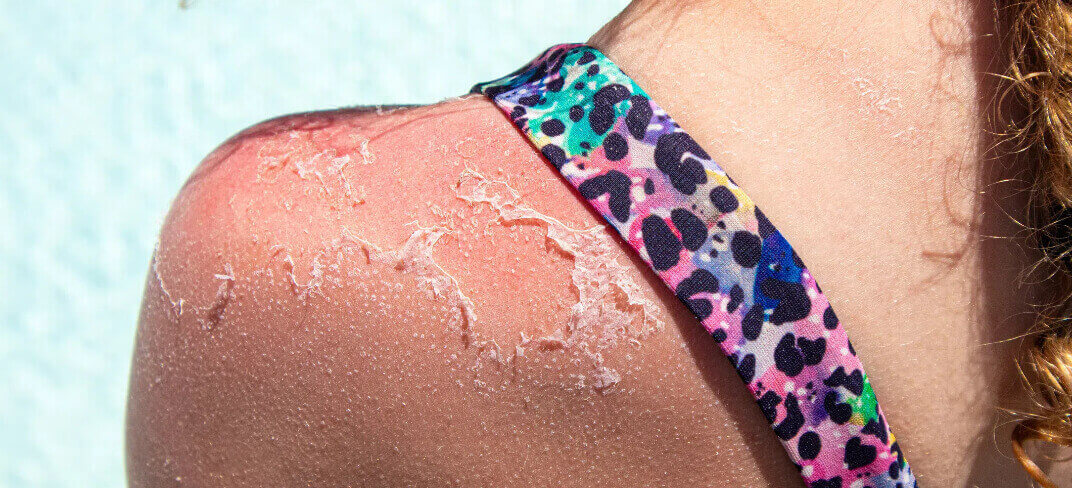Sunburn or Sun Poisoning? Tell the Difference

Editor’s Note: This article was originally published on 7 August 2024 and updated on 12 August 2025.
Prolonged exposure to ultraviolet (UV) rays without proper protection can cause skin damages of varying severity - often underestimated. While “sunburn” and “sunburn injury” are commonly used interchangeably, they differ in terms of symptoms, seriousness, and the care required.
In this article, we explain how to recognize the signs of sun-related skin damage and when a soothing cream is enough - or when it is time to take further action.
A practical guide to enjoying the sun safely and protecting your skin all summer long.
Is it Sunburn or a Severe Sunburn?
Distinguishing between sunburn and severe sunburn can be complicated. Here’s how to do it:
- Sunburn: This manifests as skin redness that, while causing discomfort, tends to resolve within a few days with the help of soothing creams.
- Severe Sunburn: This is a more serious form of skin irritation. Symptoms include hives, blisters, and what is commonly known as "sunburn erythema." These signs indicate deeper skin damage, requiring specific treatments and greater attention.
Symptoms of Sunburn
Sunburn occurs when the skin is exposed to the sun for a prolonged period, causing irritation and redness. The severity of the sunburn depends on the affected body part, the duration of exposure, and skin type. Here are some symptoms of sunburn:
- Redness of the skin.
- Swelling.
- Itching.
- Warm or tender skin.
In some cases, severe sunburn can cause flu-like symptoms such as fever, chills, and headache.
Symptoms of Severe Sunburn
Severe sunburn, unlike regular sunburn, is a more serious reaction of the skin to excessive UV exposure, comparable to an allergic reaction. This issue arises when too much time is spent in the sun without adequate protection. Symptoms of severe sunburn include those of regular sunburn but are exacerbated by additional signs such as:
- Hives or skin rash, commonly known as sunburn erythema.
- Blisters.
- Dehydration.
- Headache or dizziness.
- Fever or chills.
- Nausea.
If you experience any of these symptoms, it is crucial to move immediately to a cool, shaded area away from direct sunlight and seek medical assistance if the symptoms persist or worsen.
Treatment for Severe Sunburn
To alleviate the pain or discomfort of severe sunburn, you can follow these tips:
- Hydrate: Drink plenty of water or beverages containing electrolytes to combat dehydration.
- Soothe the irritated area: Apply a cool (but not cold) compress or use aloe vera gel to calm the inflammation.
- Avoid scratching or bursting blisters: This can worsen the condition and increase the risk of infection.
- Gently exfoliate peeling skin: Be careful not to further irritate the skin.
- Avoid further sun exposure: Protect the damaged skin to prevent additional damage.
- Take pain relievers: Ibuprofen or Naproxen can help reduce pain and swelling.
Most sunburns and severe sunburns can be effectively treated at home. However, if symptoms include severe nausea, fever, or dizziness, it is advisable to consult a doctor.
Protecting the Skin from the Sun
The best way to avoid sunburn or severe sunburn is prevention. Here are some useful tips:
- Wear protective clothing: If you plan to be in the sun for a long time, opt for a wide-brimmed hat and a light-colored shirt.
- Use sunscreen: Apply broad-spectrum sunscreen with at least 30 SPF 15-30 minutes before exposure. Remember to reapply it periodically, especially after swimming or sweating.
- Avoid peak hours: Try not to expose yourself to UV rays during the central hours of the day, generally between 10:00 AM and 4:00 PM, when the sun is strongest.
- Listen to your body: If you start feeling your skin burn, move immediately to the shade to prevent further damage.
Following these simple rules will help you enjoy the sun safely and protect your skin from the harmful effects of UV rays.
Healthy skin needs protection all year round.